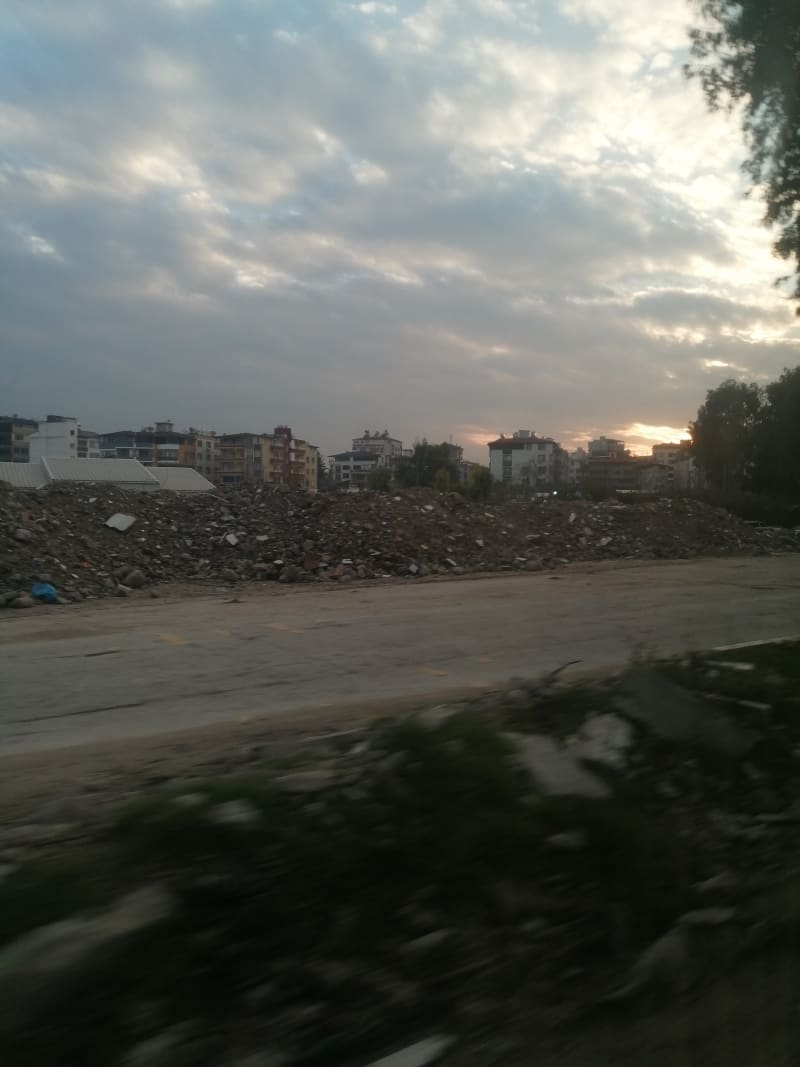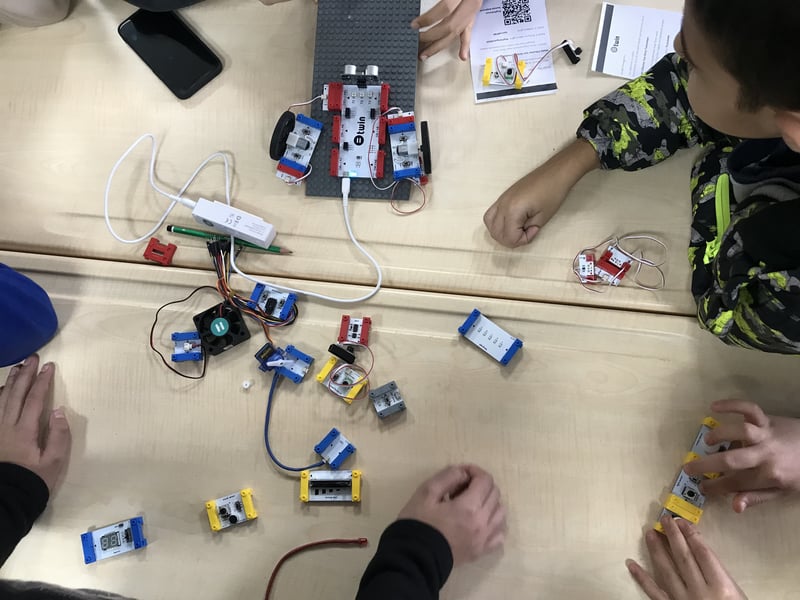
Abdurrahman Rajab
Posted on January 30, 2024

I was born in a culture that promotes humble behavior and values selflessness and altruism in human behavior. Valuing humility made it hard to talk about my skills or show off; I firmly believed that my work would speak for itself and should not mention charity work anywhere. With all that, sometimes sharing my charity work with the community is odd since it would create a personal conflict. This conflict makes me wonder what the primary goal of writing this is. Is it personal branding or a way to show the impact, motivate others to do good work, and show our humanity as screen (tech) people?
I prefer to think about the latter even though the former would happen. In this blog, I will share my recent volunteering experience with an NGO providing children leadership and tech education. I had a chance to go to the earthquake area and provide a robotic workshop to the affected children to show them good examples and role models and motivate them to impact the community through STEM and be good samaritans.
Earthquake impact
Even though the earthquake happened around a year ago yet, the impact is still visible in the community there. The people still live in containers, have no homes, buildings are about to crash, and roads are not fully repaired. With all of this, someone would ask, how would people continue living here? What can we do, and what is the impact on children?
Before jumping into the work we did with children, I would like to give a short introduction about the NGO I volunteered with. The Turkish NGO has the idea of fostering double-winged role models. Double-winged means competent and compassionate people simultaneously. As a human, if you are competent, you would use your skills for both bad and good, but to make sure that the competent people are using their skills for good, the NGO is adding a compassionate wing for people. It grows them through direct involvement in projects and activities and, simultaneously, by exposing them to leaders and role models in the industry.
After the earthquake, the NGO decided to funnel all of its efforts into supporting the earthquake-affected people, those who lost their homes and those who might have lost their families.
24 hours journey
Our trip started at 3 am and ended at almost 1 am the next day. The schedule included the flight from the city to the earthquake zone, the breakfast, and the road time. The earthquake destroyed the city airport, so we had to fly to another city and go to the zone by bus.
The images of the buildings you see on the road would tell you that the city has become a ghost city. It's similar to the cities you see in the movies, with destroyed buildings around the area. Only a few buildings are up. With this, a human would wonder how many people we have lost. How many Steve Jobs, Bill Gates, or even fathers who wanted to bring a gift to their daughters have been lost under these rubbles? At the same time, I wondered what results we would have with children and what impact we could have on them. Would we ignite their curiosity to improve in the future and be the scientists who would do the research and work to prevent such disasters in the future?
When we arrived at the school, we talked about having our workshop; we had a pre-workshop time with the teachers and spoke about their experiences and the results they reached at their school. You would be shocked by how much they stayed strong after a disastrous situation like the earthquake; I still remember that the school manager said that they lost (either left the city or died) all of their students due to the earthquake, and the number dropped down from 800 to 150. Yet they decided to stay strong and build up the school again. By building up again, I mean getting the furniture, fixing the impacted walls, and even buying new classes. They could return to 720 students within a year, a huge milestone.
At the same time, we had a chance to introduce ourselves as a team. Thankfully, the volunteering team consisted of volunteers who had been in this situation before, volunteers who were studying in the USA, high school student volunteers, and even graduates who all came together to provide an educational journey for the students.
Tough questions at a young age
One of our volunteers had a great question, which he described as the next: We previously hosted such events and had struggles; I would like to know the readiness of the children joining our tech workshops. I once had a child who asked me, "I lost my dad during the earthquake. Are you here to teach me about technology? it's meaningless." This question previously broke my heart, and I wanted to know if we might get a similar reaction.
Such questions and reactions from the children are typical in such a situation. Imagine losing your hero in front of your eyes! Even worse, some people would have lost all of their families at once. Such a situation was challenging, and we needed to be ready for whatever reaction we got from the students.
Thankfully, the school managers affirmed that many children get over the situation and we might not have such questions in this workshop. After the introduction talk, we had a great breakfast from the host school. They introduced us to the local food of their region, which is similar to Syrian and Middle Eastern food. After that, we had a short time to review the workshop content and educational kit we were using to teach children, and then we had our workshop.
A Safe place for experimentation
During the workshop, we focused on two things.
- Let the children think and explore
- Let the children be free to make mistakes
The goal here is not the technology itself but the scientific and trial-error approach we have in science, which we tried to provide to children. This approach enables the children to wonder and ask questions about what we do, even lets them make mistakes, and helps them find the correct answers. Finally, we built a remote-controlled car with the children. That allowed the children to play and learn by exploring the educational kit!
While building the car, we had a chance to talk with children since the workshop population was two volunteers for every four children; this allowed room for a personal connection with children and asking them about their thoughts and ideas. Before working on the car, we had a short, interactive presentation with the children in which we asked them questions about vehicles, fossil-based energy, and clean energy in general. We had great answers from the children (they were in 5th and 6th grade). Some mentioned the value of clean energy on Earth, humans, and nature. Others mentioned the value of noise canceling from the electric car. The noise conversation leads to a conversation about how to help visually impaired people identify and notice the car. All of these conversations and insights would not be feasible if we did not create a trusting atmosphere between children and volunteers, and it enabled us to dig further to find the gems in the hearts of those children.
The volunteering impact
After the workshop, we had dinner and returned home. On our way back, we had an intimate talk with the team to discuss the day, mostly thinking about What went well, what we thought, how we felt, and how such an experiment impacted us.
With this, everyone from the volunteers shared their thoughts and discussed them with the team, a great exercise that helped us be vulnerable and close to each other and our feelings.
A few thoughts we had discussed:
Even if we lost something in life, like a father or close person, we could still live up to their expectations. They would not like us to cry or grieve, yet they would like us to stay strong and move forward; such a thing could be the answer to my friend at the beginning of the day.
Moving as a team is an excellent key to the success of such a movement; we have people who worked from the office to organize the workshop, people who invented the tools, and people who had to do all the calls and stay up at night to talk with the drivers to find us, we all played a small part int he whole game.
Even if everything collapses, we must move forward and do good in the world. We might not see the result of the goods, but they will grow over time; they're like a tree you plant; you might die, but the impact will live as long as it's there. The tree you plant could have someone or a bird to benefit from, which is a huge thing to have. In our culture, we even have a saying by prophet Mohammad (SAW): If the Final Hour (apocalypse) comes while you have a shoot of a plant in your hands and it is possible to plant it before the Hour comes, you should plant it.
Ultimately, this experience reminded some volunteers of the value of NGO involvement. If you work or study full-time, you might get disconnected from the world and focus on your small world. Concentrating on your study or work will make you forget the whole world. Volunteering and visiting disastrous impacted areas will remind you of your humanity and ignite your goodness.
Personally, I have been disconnected from the NGO for 2-3 years, but I feel that everyone should have a thing once each quarter to remind us of our humanity and keep us in touch with our human selves in the entire career world.
In the end, I would like to thank everyone who was involved in such a project: Selen, Bengisu, Deniz, Nisanur, Kübra, Muhammed, Recep, Gökhan, Sare, Ali, Oktay, Yazgı, Yunus. It was a great experience showing the value of teamwork, meeting for the same purpose, and even the impact of our work on others.
What about you? Do you have any volunteering experience that impacted your thoughts?

Posted on January 30, 2024
Join Our Newsletter. No Spam, Only the good stuff.
Sign up to receive the latest update from our blog.


